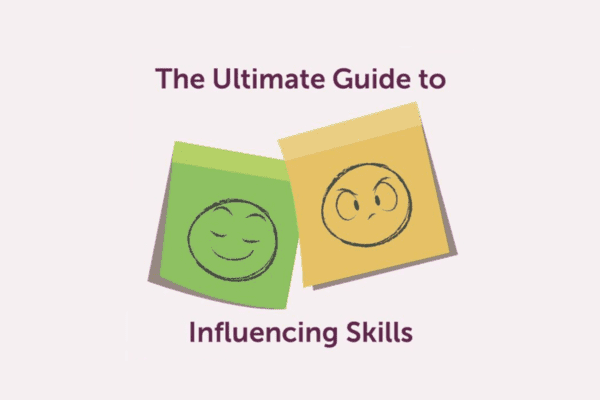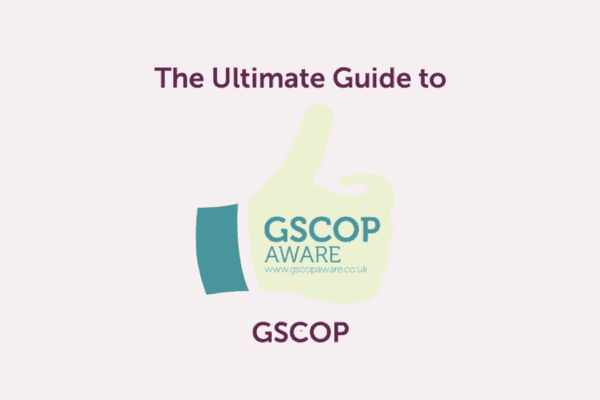What are Coaching Skills?
Coaching skills revolve around the fundamental principle of assisting others in their learning journey. And all while refraining from providing direct instructions or opinions. The essence lies in enabling the person being coached to generate their own ideas and make their own decisions.
This approach facilitates individuals in realising their untapped potential, as it empowers them to unlock their thinking and eliminate self-imposed barriers. Alos, it is important to acknowledge that these obstacles are frequently of a mental nature, originating from within the individual being coached.
Coaching is unlocking a person’s potential to maximise their own performance.” – Timothy Gallwey
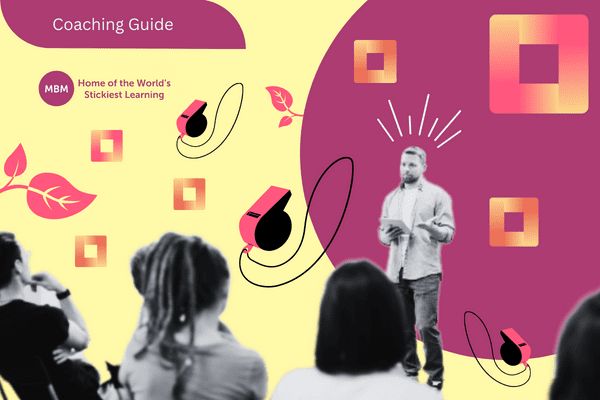
This Ultimate Guide will Cover:
- Coaching and The Role of a Coach
- Coaching Defined
- Coaching and Mentoring Skills
- History of Coaching
- Why Coaching Works: The Science Bit
- A Model for Coaching
- GROW Model Questions
- Other Coaching Models
- Seven Coaching Tools to Make the Learnings Stick
- The Top Ten Effective Coaching Skills
- Coaching Skills for Managers and Supervisors
- Ten Top Tips for Being a Really Great Coach
- Further Reading and Resources
1) Coaching and The Role of a Coach

So, what exactly is the role of a coach? A coach facilitates learning, using their skills to help an individual (the coachee) to improve their own performance.
We mentioned above that the term ‘coaching’ is often misunderstood and it’s easy to see why. When we look at the Oxford English Dictionary, several definitions come up, all along the lines of:
- To train or instruct.
- Provide (someone) instructions about what to do or say in a particular situation.
- Give professional advice on how to meet goals.
It is misunderstood because all of the definitions tend to refer to teaching, telling or advising. They imply that the coach is an expert of some sort. However, in our context, this is exactly what coaching isn’t!
The development of skills in coaching has become a very hot topic for organisations over the last few decades. Millions of articles have been written about coaching. In fact, if you Google it, you’ll get over one billion results.

However, despite the wealth of information, the term is still often misunderstood.
Let’s Set the Facts Straight…
In this Ultimate Guide, we aim to explain what coaching is. Also, we will give you further insight into the key skills required for a great coach.
Whether you’re a leader or manager, an internal coach or a professional coach, there are several key skills that you need to develop to coach effectively. We will help you understand what they are and provide you with some useful tools and tips. Furthermore, we will also give you some examples of the best resources to help you continue to develop your coaching skill.
2) Coaching Skills Defined
The following quote is from one of the fathers of modern-day coaching, the late Sir John Whitmore, who gave a nice definition of what coaching is:
Coaching is unlocking a person’s potential to maximise their own performance. It is helping them to learn rather than teaching them.’ – Sir John Whitmore.
Coaching is based on the belief that the coachee always has the answers to their own problems – and that’s why it’s so empowering! Your coachee might, however, need some help to find their answers – and that is where your essential skills come in.
So, in coaching, the responsibility for learning lies with the individual, and not with you, the coach. The great news is that this form of learning is much more empowering for the individual, creates ownership, and has better longer-lasting performance results. There is something almost magical about it. It just works.
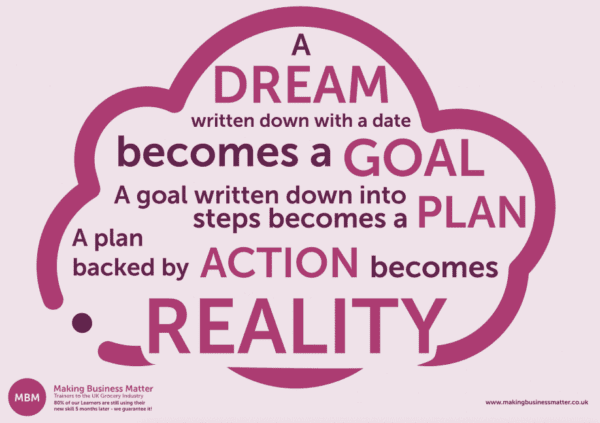
3) Coaching and Mentoring Skills
It is important to understand the difference between coaching and mentoring skills as they are two distinct things. However, these terms are often used interchangeably.
In mentoring, the mentor advises and shares their own experiences and is usually more experienced and qualified than the learner (or ‘mentee’). Furthermore, mentoring is a more long-term, ongoing relationship that takes a broader view of the person, with the mentor providing support and guidance to prepare the learner for possible future roles. So, mentoring revolves more around developing the person professionally.
In coaching, the coach doesn’t advise and all the ‘content’ is the coachees. For this reason, the coach does not need to have direct experience with the coachee’s role. Furthermore, the coaching is usually focused on specific development areas or issues. Finally, the agenda is very much focused on achieving goals.
There are, of course, other learning methods in addition to coaching and mentoring skills. The infographic below shows the difference in ethos between the various methods that help people learn and develop:
Click the image below for a higher resolution.

4) The History of Skills for Coaching
Coaching has a long history dating right back to Socrates. The Socratic method took the premise that people learn best when they have some ownership of a situation and take some form of personal responsibility for the outcome. Consequently, the process favoured dialogue between individuals to promote critical thinking and to draw out ideas and underlying presumptions.
In modern times, coaching has played a critical role in sports such as tennis, cycling and football. But it was Tim Gallwey and Sir John Whitmore who took the movement of coaching from the sporting arena into the business world.
In the early 1970s, Tim Gallwey, who was coaching tennis students, began to notice that what was going on in the mind of his students was hindering learning. He started experimenting with ways of helping players learn by developing their awareness – and not by specific instruction. He gave it the term ‘The Inner Game’ and published his initial findings in The Inner Game of Tennis in 1974.
Later that decade, Sir John Whitmore, an ex-racing driver who had become interested in the field of psychology, trained with Gallwey and realised that these principles could be applied to business. He continued his research, and in 1992 published the book Coaching for Performance. The principles of his book are still used extensively in businesses today.
5) The Science Bit
There has been much research in recent decades into how the human brain works. Consequently, we are better able to understand the science behind why coaching in the workplace really works and helps learning stick!
Brain Maps, Learning and Habits
Our brains basically function by making connections and associations. Brains like to link what is happening now with what has happened in the past; we create a kind of mental ‘map’ of connections. We actually make over 1 million new connections every second!
When we first come across something, it takes us a while to get to grips with it. So if we are learning a new skill, it might take minutes, days or even months, depending on the complexity of what we are learning. Our brains gradually create a ‘map’ and this takes a lot of energy. But once the map is created, our brains can focus on other things. We call this process forming a habit. Habits are run by the more energy-efficient parts of our brains. Quite simply, our brains operate by forming habits.
Your Amazing Brain
The other thing we need to understand when we are talking about coaching and how brains learn is the concept of ‘neuroplasticity‘. In the book ‘The Brain that Changes Itself’, Norman Doidge points out that there is real evidence that we can ‘rewire our brains with our thoughts’. Supporting this is Hebbian theory, developed by Donald Hebb back in the late 1940s. Hebb’s theory of neuroscience can be summarised as: ‘neurons that fire together wire together’. It posits that when we learn new things, the nerve cells within the brain begin to change to fit the required processes. Therefore, the more you focus on something, the more you analyse a problem, and the deeper the connection you create in your brain.
This occurs through a physical process in the brain called ‘myelination’: the more a pathway is used, the stronger it becomes. When we repeat an action, myelin, a fatty covering, coats the neural pathway, making connections stronger and more secure.
This explains why it is hard to change habits but easier to create new ways of working. Very simply, it’s because our brains prefer to go with the neural pathways that are already developed.
Coaching vs. Telling
The above theory explains why coaching works much better than telling in the world of learning. When we are told something, we don’t create a new mental map. However, when we gain insight from thinking about something in-depth, we do. It’s as simple as that. Consequently, providing insight through coaching (i.e. asking questions) is much more brain-friendly than telling someone the answer. To take any kind of action, we have to work things out for ourselves.
Furthermore, an additional issue with telling is that it is more likely to set up a ‘threat response’, as the individual’s predictions and connections are different to what was expected. This difference creates an ‘error message’ and a sense of pain in the brain. This, in turn, moves people away from the new information and increases the likelihood of resistance.
Therefore, if we tell rather than coach, we could be wasting our own energy and actually making it more difficult for our coachee to get to grips with a new idea. The coach’s job is to create insight, not to give advice. However, from clients’ testimonials of trainee coaches, in practice, this is easier said than done!
6) A Model for Coaching Skills
The GROW Model for Improving Coaching Skills
Any article on coaching would not be complete without reference to the most famous coaching model, the GROW model. The model was originally developed in the 1980s by business coaches Graham Alexander, Alan Fine, and Sir John Whitmore. It quickly became the go-to tool for leadership coaching, upon the publication of Coaching for Performance by Sir John Whitmore in 1992.
It consists of four stages, based on each letter of the word, G.R.O.W.
Click the image below for a higher resolution:

How Does it Work in Coaching Skills?
The coachee starts at ‘Goal’ (G), where they define their initial outcome(s) and goals with the aid of coach questioning. The next stage ‘Reality’ (R), requires the coachee to explore and describe their current state. The coach helps by asking questions that encourage self-assessment and evaluation. The following stage ‘Options’ (O), explores how the coachee can reach their goal, examining all possible options.
Then the coach invites suggestions and uses supporting tools such as mind maps to make sure all options (regardless of how abstract) are fully explored. The coach may offer suggestions, however carefully and sparingly, and only once the coachee has explored their own options/suggestions first. In the last stage ‘Will’ (W), sometimes called ‘Way Forward’ or ‘Wrap Up’, the coachee is encouraged to commit to an option or specific action with the coach helping to support and motivate.
Awareness and Responsibility
Sir John Whitmore advocated that coaching was all about developing or raising two things in the coachee, their level of awareness and their level of responsibility.
If I give you my advice and it fails, you will blame me. I have traded my advice for your responsibility and that is seldom a good deal.’ – Sir John Whitmore
A Different Perspective: The Growth Model
The image, below, provides a different way to think about the GROW model, by extending it to include tactics and habits:
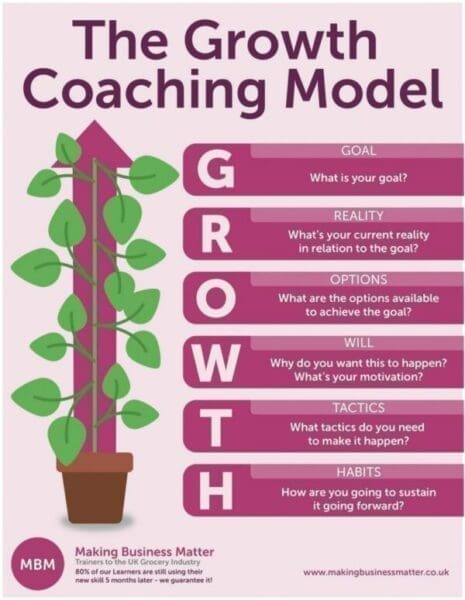
7) GROW Model Questions to Enhance Your Skills
In the image below, we have provided some examples of effective questions to use at each stage of the GROW model:

Improve Your Coaching With our Coaching Skills Cards
Whether you are managing people, beginning your coaching journey at work, or are a qualified coach, these cards provide an easily accessible way of using the GROW coaching model as a framework to get results.
Click the image below to learn more:
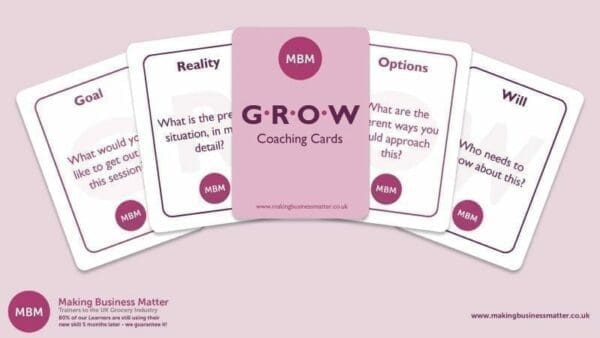
To further your understanding and skills, check out our Online Free Tools for each of the Coaching Cards.
8) Other Coaching Models to be Used with Your Coaching Skills
The following are examples of two models that have extended and developed the GROW Model. Interestingly, they have particular relevance for managers looking to develop their skills as a coach.
OSCAR Coaching Skills Model
An interesting alternative to GROW is the OSCAR Coaching Model, a further way to ensure you have solution-based coaching. The OSCAR Coaching Model was developed by Andrew Gilbert & Karen Whittleworth in 2002. The model builds on the GROW model and is particularly useful for managers seeking to adopt a coaching style. It takes the following structure:
- Outcome – help the coachee (or team member) to clarify their outcomes.
- Situation – establish where the coachee is now.
- Choices and Consequences – help the coachee generate as many choices as possible and highlight the consequences of each potential choice.
- Actions – help the coachee establish their next steps, and encourage responsibility for their action plan.
- Review – create an ongoing dialogue of review and evaluation with the coachee continuously checking that they are on course.
OSKAR Coaching Skills Model
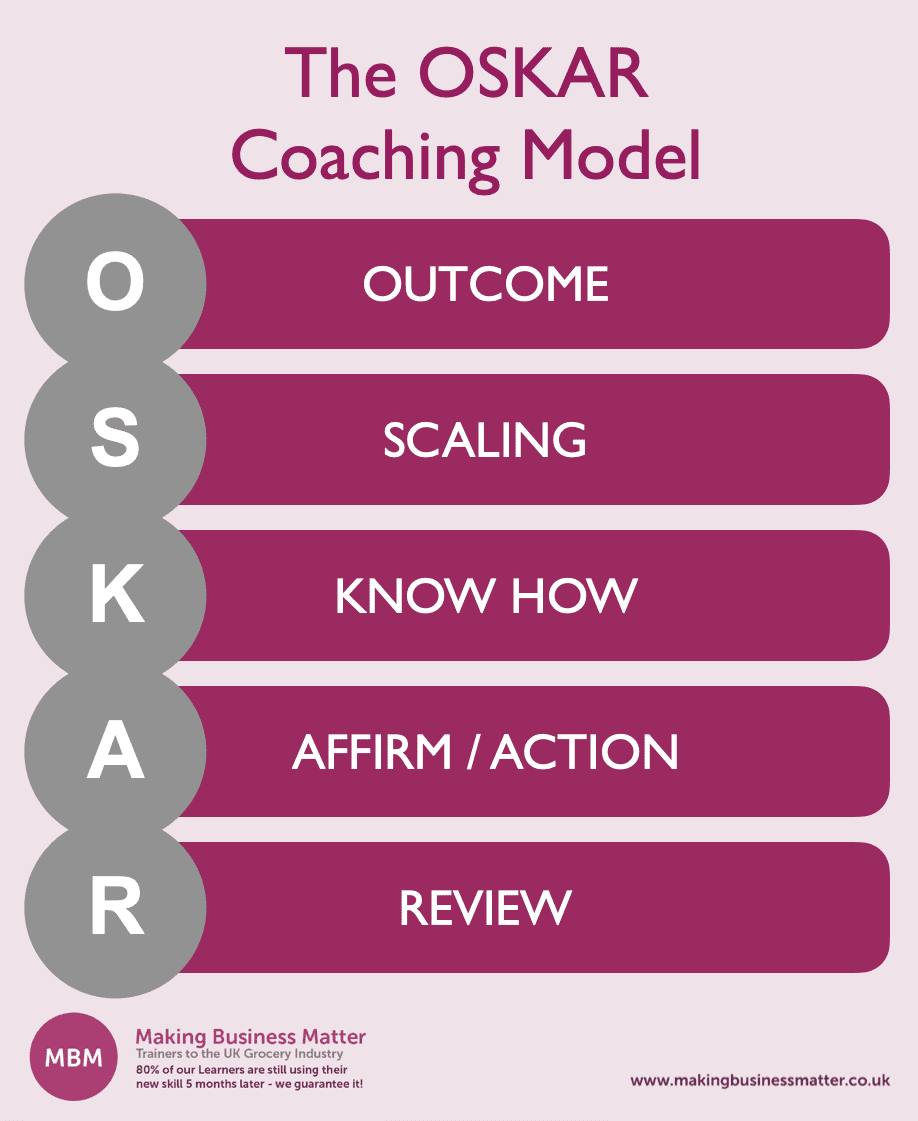
Similar to OSCAR, the OSKAR Coaching Model was developed by Mark McKergow and Paul Z Jackson in the early 2000s.
- Outcome – help the coachee establish outcome(s) and objectives.
- Scaling – utilise a scale from 1-10 to establish and quantify how far the coachee is from where they want to be (desired outcome).
- Know-how – help the coachee explore what they need to achieve their desired outcome (and move along the scale), exploring the critical skills, knowledge, qualifications, and attributes that are required.
- Affirm + Action – establish what is currently working well, and explore actions needed to improve the score.
- Review – discuss actions taken, and decide what has improved and what the coachee needs to do next to continue the improvement.
You can find some examples of OSCAR/OSKAR Coaching Model questions in our GROW Model Coaching Effective Questions article.
To Pause, Here’s a Little Bit About Us…
We are the soft skills training provider, partnering with clients that are frustrated by people returning from training courses and then doing nothing differently. Our clients choose us because we achieve behavioural change through our unique training method, sticky learning ®.
Click the banner below to learn more:

9) Seven Tools to Make the Learnings Stick
In the infographic below you can find seven useful tools and theories we draw upon in our Executive Coaching course.
Click the image below for a higher resolution.
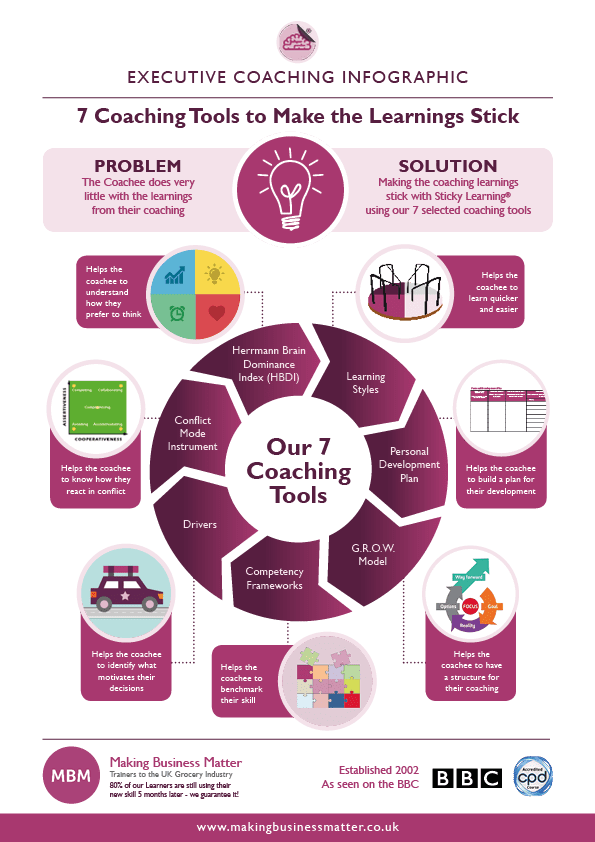
#1- Learning Styles
At MBM we know that everyone is different. As such, we all learn in different ways. By understanding the different styles of learning we can tailor our approach to the individual needs of the coachee. This, in turn, helps the coachee learn quicker and easier, thus, maximising the short and long-term benefits of the coaching course.
#2- Personal Development Plan
Continuous personal development is best achieved with a plan of action detailing your aspirations across many areas. Personal Development Plans (PDPs), sometimes called Individual Development Plans (IDPs) are an important part of your personal and professional development.
Having a visual plan of where you are now, where you see yourself in the future, and what steps you need to make it happen is an excellent starting place. You can find some Personal Development Plan examples in our blog article. We’ve also compiled a list of some of the best learning videos and a useful list of TED Talks on the subject too.
#3- GROW Model
GROW is the go-to model for coaching. You can find our history and overview earlier in this article on skills in coaching.
#4- Competency Frameworks
Competency Frameworks and Skills Scorecards comprise a set of attributes and behaviours written by an employer that broadly defines what the company expects from a person in any role or de-compartmentalisation of that role, thus benchmarking it. Frameworks are often used for development discussions, as a recruitment tool and as a performance management aid. To learn more, take a look at our blog article about Competency Frameworks and download a free example.
#5- Drivers
Drivers are unconscious internal pressures that make us do things in certain ways. They can sometimes (not always) be inappropriate or unhelpful in obtaining results, and tend to satisfy inner needs rather than actual events. Drivers are good for identifying external signs that reflect internal processes. We use a Drivers Questionnaire to help our coachees understand what drives them.
Click the image below for a higher resolution.
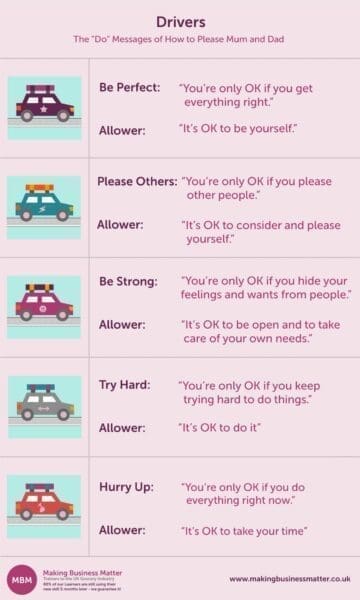
#6- Conflict Mode Instrument
Conflict Resolution Training is a natural part of how we interact with others. But it is not as negative as the connotation suggests. In fact, it can be beneficial in the workplace. If managed correctly, it can improve workplace cohesion and lead to greater goal clarity.
The Thomas-Kilmann Conflict Mode Instrument (TKI) helps measure how a person behaves when presented with a conflict situation. It analyses the dimensions of assertiveness and cooperativeness. Contact us to receive a copy of the tool we use to help the coachee identify and assess their conflict resolution skills.
#7- HBDI®
Founded by Willian ‘Ned’ Herrmann, HBDI® (Herrmann Brain Dominance Instrument) is a psychometric assessment tool that identifies an individual’s thought preferences. By understanding your thought preferences, you can consequently achieve a greater appreciation for how you learn, which in turn, helps decision-making, problem-solving, and communication.
See our HBDI Ultimate Guide to learn more.
For further understanding, take a look at this excellent article by Ann Herrmann-Nehdi which explores how essential understanding how you think can be to the coaching process, ensuring you ‘set up your coaching with your brain in mind’.
10) The Top Ten Effective Coaching Skills

Coaching is about providing the right balance of two things to your coachee: support and challenge. There are several essential skills a good coach needs in order to do this. Let us explore these below:
#1- Listening
This is so important that we put it at the top of the list. You can’t be a good coach unless you really, really listen. Note, it doesn’t just mean listening to what is being said. It also means listening to what is not being said. This is where you can really help your coachee – by asking insightful questions about what you notice might be going on for them.
The GROW model identifies four levels of listening skills:
- Attentive listening – giving someone full attention.
- Accurate listening – understanding the issue at hand fully.
- Empathetic listening – showing appreciation for the other person’s feelings on the issue at hand. Put yourself in their shoes.
- Generative listening – fully understanding the issue at hand, which allows you to ask enlightening and insightful questions.
#2- Questioning
Asking questions is at the heart of great coaching. They are the tools of your trade. There are so many different types of questions that can be used. Some are more helpful than others. The best questions are ones that give insight into the person you are coaching. The best way to remind yourself of open questions is ‘5 Bums on a Rugby Post’.
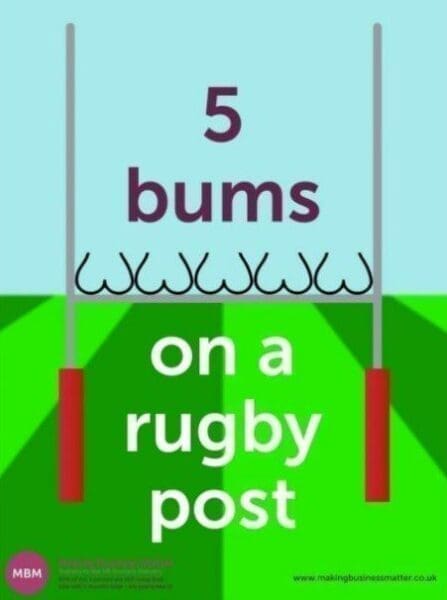
Start your open questions with either: what, where, when, who, why, and also how (the ‘H’ is the Rugby post!)
In a ‘pure’ coaching scenario, only open questions are used, so that the agenda is fully under the control of the coachee. However, in practice, it’s always good to use closed questions to clarify things or probing questions to dig a bit deeper.
Over time you will develop a set of great coaching questions that work for you.
Here are a few of our favourites:
- What would the wisest person you know advise you to do right now?
- What would be a crazy/ radical/ brave thing to do?
- If you could wave a magic wand, what would be happening differently?
- What’s stopping you?
- What’s really going on for you?
- What else? (ask this several times over, you’ll always get more ideas).
- What is the best question I could ask you now?
- Is there anything you believe about yourself that might be holding you back?
- What have you learnt/ are you learning about yourself through this process?
- What’s the best/ worst thing that could happen?
Our best tip for asking great questions? Go with your own curiosity.
#3- Building Rapport
This is chronologically the first skill you need to use as a coach as it is the gateway to trust. The coaching process will not work unless you create a good rapport from the beginning, and it should be maintained throughout the coaching relationship. Rapport is what allows coachees to feel relaxed with their coach and open up – so that personal barriers and fears can be identified. It also allows the coach to ask harder and more challenging questions.
Some of the key things that emerge when building rapport are empathising (see below), the use of body language, the use of voice and language and the importance of being warm and personable. It’s easier, for example, to create rapport with someone who provides eye contact and smiles. It’s better to sit at right angles with your coachee than opposite them. You can also gently match and mirror their body language.
It’s also worth noting that coaching is a bit like dating. There are just some people that you won’t click with. If you feel like you can’t develop a rapport together, it’s better to acknowledge this early and find the coachee an alternative coach. Rather this, than try and keep the coaching relationship going when the coachee is unlikely to open up and trust you.
Successful coaching is a direct result of rapport. For effective coaching, you can make use of the Herrmann Brain Dominance Instrument (HBDI®) to accurately identify the true capacity of the people you coach.
#4- Empathising
Empathy can be defined as our ability to put ourselves in others’ shoes and appreciate how they are likely to be feeling or thinking in a given situation. What might it feel like to be them?
Daniel Goleman, who coined the concept of ‘Emotional Intelligence’ stated that ’empathy is the most important people skill’. He says that empathy is an important communication skill, but it can be easily forgotten because we focus on what should be done in a situation, rather than on how the other person feels.
The effect of empathy is to help you to understand the other person’s needs and to show an understanding of their views and feelings. This is really important when creating trust and rapport in the coaching relationship.
It’s also worth remembering that empathy is different from sympathy. When we empathise we become one with that person’s distress. You put yourself in their shoes and imagine what they are going through. You don’t necessarily share their feelings, however, but you understand it from their perspective. In contrast, sympathy is feeling compassion or sorrow for the hardships that another person is experiencing.
#5- Summarising and Reflecting
The advanced listening skills of summarising and reflecting help you guide your coachee to allow them to make sense of what they are grappling with.
Summarising means repeating what the coachee has said, taking the main points of the received message and reiterating them. Done in a logical and clear way, it gives the coachee a chance to correct something if necessary. Summarising is useful as it keeps the coachee focussed on the issue and their thinking progress so far.
Reflecting means closely repeating or paraphrasing what the coachee has said to show comprehension. Reflection is a powerful skill that can reinforce the thoughts of the coachee. It allows the coachee to step back and look at an issue objectively.
For further research and information on executive coaching, we suggest taking a look at Diane Coutu and Carol Kauffman’s excellent article for Harvard Business Review: ‘What Can Coaches Do for You?’.
#6- Unlocking Limiting Beliefs
This skill is about using your intuition and then asking challenging questions. Underneath the initial symptom or issue, there is usually something deeper.
Beliefs are a ‘principle accepted as true or real without proof’. Beliefs are strange things. We all have them and often don’t even question them. We hold them as true even if we have no evidence to support them.
Our beliefs have a major impact on our behaviour. Some beliefs can help us become successful; others can hold us back, these are known as ‘limiting beliefs’. Limiting beliefs can get people stuck.
Helping your coachee identify and challenge underlying limiting beliefs can, consequently, be one of the most powerful parts of the coaching process and can be an enlightening and even emotional process for the coachee. The role of a coach is to get people to question their inner beliefs. In order for a coach to do this, there has to be a foundation of trust and rapport.
#7- Staying Focused
It’s really important as a coach to make sure that the coaching session stays on track and does not degenerate into a general discussion or chat. It’s also important to ensure the coachee doesn’t digress too much or get caught up in too much detail.
Staying focused can involve summarising and guiding the flow of the conversation back to a framework such as the GROW model, using further questioning. It can also mean interjecting from time to time to pull things back on track.
#8- Being Non-Judgemental and Open-Minded
This is a critical skill which is the foundation of good coaching. As a coach, it’s simple: we don’t get to judge another human being. Being a great coach is about being curious and having an open and inquisitive mind. This will allow you to focus on doing the best for your coachee by reflecting, providing feedback and asking great questions.
Being open-minded means understanding that other people have different points of view and that in their view of the world, they may be right.
#9- Giving Constructive Feedback
One of the most useful things for your coachee can be you pointing out to them things you are noticing about them. For instance, their behaviour, their reactions to questions, and their facial expressions. Sometimes people don’t see stuff about themselves and often others won’t be brave enough to tell them.
As a coach, you have a privileged position of trust where you can point these things out to them, so it is well received and helps them with their issues. The picture below highlights some of the important areas to cover when giving great feedback.

There is an art to giving supportive feedback so that it lands well. Not being judgemental (see Skill 8 above) is key. Furthermore, make sure your feedback is constructive, specific, and observed. ‘Here’s something I’m noticing…’ is a good way to start and a great coaching skill for leaders.
#10- Resisting Temptation to Tell
Not telling your coachee what you think the answers are or giving advice. We have talked about this a lot in this article, but it’s so important we thought we’d mention it again. See in the Coaching Skills guide above. It is hard to master so we’ve classed it as a skill.
Business Coaching
When individuals improve, the entire team performs better, and that makes coaching a vital component in organisations. This has become especially relevant in the competitive, high-speed world we live in today. Coaching is now recognised as one of the most powerful interventions for accelerating learning and driving organisational performance, as such many organisations are investing in skills in coaching for leaders and skills in coaching for managers.
Executive Coaching
Executive coaching is where an employee (usually a leader, manager, or someone identified as having potential) receives one-to-one coaching sessions to support their leadership skills training and to further develop and deal with any individual challenges.
Many companies choose to have external coaches run these sessions. Having an impartial coach can help leaders to open up and deal with difficult situations faster. Some companies, however, use internal coaches. These are often people in an existing line role who add coaching as an extra discipline to their role; other organisations have a dedicated internal coaching team.
Personal coaching plans for people receiving coaching sessions in organisations will typically run for up to 6-12 months. They will encompass the setting of, and achievement of, a set goal or goals. It might help, such as, to perceive those you coach as athletes who want to become better in their game.
In the workplace scenario, the goal is to help employees refine their skills, based on the institution’s competency framework. Without a doubt, the greatest reason companies use coaches is to increase the emotional intelligence of senior leaders and high-potential staff. To learn more about this, see our Coaching Skills for Leaders section in our Ultimate Guide to Leadership Skills.
Manager as Coach
It has been recognised in recent decades that managers can get the best out of people by using coaching, rather than the ‘telling’ approach.
Google’s Project Oxygen proved categorically the positive impact that a coaching approach can make on staff motivation and performance. In a multi-year research project, they used rigorous data analytics to demonstrate the link between skills in coaching for managers/management behaviour and positive people results, proving to their staff once and for all that ‘management mattered’.
In fact not only did they prove that management mattered; Google went on to identify eight key behaviours demonstrated by the company’s most effective managers. Moreover, being a good coach was cited as the very first attribute:

11) Coaching Skills for Managers and Supervisors
So, if you’re a manager looking to coach your team, where do you start building your skills in coaching for managers?
Well, let’s look at a typical conversation between a manager and someone in their team:
Individual: ‘I’ve got a problem’.
Manager Response 1: ‘Yes and what are you going to do about it?’.
Now let’s look at a different approach:
Individual: ‘I’ve got a problem’.
Manager Response 2: ‘What have you tried so far?‘
The second response is much better because it assumes the manager believes they have the capacity to solve the problem. It assumes that the individual has done something already and encourages them in the future to get into the habit of doing something before they bring it to their manager. Consequently, this is a far more positive and empowering approach.
This coaching approach moves away from a culture where the expectation is that managers have all the answers – and instead moves towards one where managers coach the answers out of their teams.
Departing From the Manager With All Answers…
As a manager, adapting to skills in coaching for the manager’s style allows you to step up and focus on the things you want to focus on. Consequently, it stops you from getting dragged into solving problems that your team members are likely capable of solving for themselves.
With a coaching approach, you are empowering and stretching your people, helping them to learn and to solve their own problems. The great news is that, like any habit, once you build this culture it sticks, and it’s contagious.
Of course, telling people is quicker – and in today’s fast-paced environment, it’s hard to resist the temptation to tell someone the answer and get the issue off your desk when you’re busy. It’s worth remembering when this temptation arises that the advantages always outweigh the disadvantages in the longer term.
If you tell your team what to do, they won’t buy into your decision, they won’t learn, and they’ll be less committed, take less responsibility and be less creative. Inevitably, they’ll be back, and you will need to tell them an answer again.
Yes, coaching takes time, but the long-term benefits are vast. People take responsibility, they learn, and they create solutions that stick and commit to those solutions. They become accustomed to generating ideas for themselves. Furthermore, coaching ignites creativity and innovation.
Ultimately, in the long term, skills in coaching for managers save time.
12) Ten Top Tips for Being a Really Great Coach
#1- Never Skimp on Building Rapport
The more you can invest in it early on, the better it will serve you. To have effective coaching skills you need trust.

#2- Establish Goals
If your coachee hasn’t got goals, you’re not coaching them. Don’t move forward with any more questions until the goal is clear. Sometimes coachees begin with clear goals. For others, however, the biggest challenge for them is to define what they want in the first place. You may need to spend some time helping them do just that!
#3- Use Open Questions
Try to stick to open questions instead of closed questions – we have already mentioned this in this effective Coaching Skills article. Open questions get people thinking. Closed questions stop people from having to think. Try to ask as few closed questions as possible.
#4- Be Content Free
Remember that the best effective skills in coaching questions bring insight to the other person, not to you! Try to focus on being ‘content-free’ when you are coaching; you don’t need to be clear about all the details – only they do.
#5- Trust Your Intuition
All coaches worry about what questions to ask next. Just use your intuition and go with your curiosity. Trust yourself to come up with the questions and develop your own effective coaching skills questions.
#6- Don’t Ask ‘Why?’
Avoid using the question ‘Why?’ It flips us back to our childhood. You can, however, replace it with ‘What?’ This opens up people’s intuition and is a great example of communication skills coaching.
#7- Highlight Interesting Behaviour(s) or Language
If you are noticing something that you find interesting in your coachee’s behaviour or language, maybe something that stands out or raises questions for you, call it out. This kind of feedback can be very powerful and great in social skills coaching.
#8- Stay on Track
Remember, in a coaching session, the ‘meter is running’. Coaching is not having a chat. Stay focused and make every moment count!
#9- Dig Deeper
The issue that first presents is never the real issue. When you can dig deep and help your coachee figure out what the real issue is (usually an unchallenged limiting belief), use your life skills in coaching to reach the real gold dust of coaching.
#10- Invest in Continuous Development
Becoming a great coach is a journey, not a destination. You can always keep developing your life coaching skills.
Understanding what effective skills in coaching really are (and what it isn’t), and how and why it works in the first place is critical to developing effective coaching techniques. Being a coach is about being a facilitator of someone else’s learning. It’s not about telling them, advising them or doing it for them. When done well, it’s one of the most empowering and powerful learning methodologies open to businesses and organisations.
One-half of your job as a coach is listening and understanding the driving force behind those you coach – what’s really going on for them. The other half is working with the individual to help them identify ways to improve their own performance so that they can unleash their full potential.
The hardest bit about coaching? Not telling the coachee what you think they should do or giving them advice. It sounds easier than it is. It’s a lot harder than you think. Those of you who have already started your coaching journey will already know this.
Good luck with developing your effective skills in coaching. Remember, if you need any help, we’re here (and, of course, we’re really listening).
Coaching Skills Training
Click here to learn more about our classroom-based Coaching Course.
To discuss how one of our UK Grocery Executive Coaches can help you to achieve more, please contact us. Our coaches are from your industry and can provide coaching on any one of our products, from Negotiation Skills to Category Management to Time Management Skills to Communication Skills Coaching and Presentation Skills coaching, using the GROW Model. Find out how we can help you be the very best version of yourself with Executive Coaching.
13) Further Reading and Resources
You can find further insight, detailed definitions and clarification of all the key Coaching terms mentioned in this guide in our Glossary of Terms.
#1- Articles from Our Blog:
- What is coaching
- Coaching approaches
- Management coaching styles
- One-sentence Coaching Tips
- How to coach
- Everyday coaching
- Coaching in the Great Unknown
- Share the Power of Coaching
#2- Quotes
‘Coaching is centred on unlocking a person’s potential to maximise his or her own performance…improving the individual with regard to performance and the development of skills.’ – Timothy Gallwey
‘Many discussions are unclear when the intention is vague or hidden. People speak around and around an issue instead of coming to the point and stating their intention.’ – Jackie Arnold
‘Coaching is a process that enables learning and development to occur and thus performance to improve.’ – Eric Parsloe
‘For the teacher or coach, the question has to be how to give instructions in such a way as to help the natural learning process of the student and not interfere with it.’ – Timothy Gallwey
‘I cannot teach anybody anything. I can only make them think.’– Socrates Books
#3- Books
The following books are some of our favourites on coaching. They will help you further your knowledge and understanding of coaching. Plus, they are full of lots of useful tools, tips and ideas that you can put into practice. Additionally, you can find more of our recommended reading for self-improvement in our Best Self Help Books post on our blog.
- Coaching for Performance: The Principles and Practice of Coaching and Leadership by Sir John Whitmore. This is where business coaching really took off and is as good and relevant today as it was when it was first written.
- 50 Top Tools for Coaching: A Complete Toolkit for Developing and Empowering People by Gillian Jones & RO Gorell. A very practical book of coaching tools suitable for various different coaching scenarios.
- The Inner Game of Tennis: The Ultimate Guide to the Mental Side of Peak Performance by Timothy Gallwey.
- The Inner Game of Work: Focus, Learning, Pleasure, and Mobility in the Workplace by Timothy Gallwey.
- OSCAR Coaching Model by Andrew Gilbert and Karen Whittleworth.
- Making Coaching Work: Creating a Coaching Culture by David Clutterbuck and David Megginson.
- Coaching Skills for Leaders in the Workplace: How to Unlock Potential and Maximise Performance by Jackie Arnold
- The 7 Habits of Highly Effective People by Stephen Covey. There are some great coaching tools in here and some great ideas about listening.
Also, take a look at our award-winning blog and its content on Coaching Tips.
#4- Videos
Subscribe to our YouTube Channel, you can get a preview by starting with our playlist on Coaching Techniques (below):


#5- Case Studies
Take a look at how some of our previous clients have benefited from Executive Coaching. You can click the image below for a higher resolution.

The links below will take you to a further selection of case studies and evaluations made by our Executive Coaching clients highlighting its benefits:


